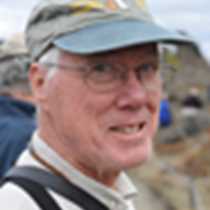Hornsund, Spitsbergen, Svalbard
Was it really only yesterday that we left Oslo for the frozen North? It seems impossible but, yes, it is true! We flew up the length of Norway and then beyond the North Cape, over the Norwegian Sea to reach the island archipelago of Svalbard. We boarded the Endeavour in the largest (and the only!) town, Longyearbyen, and we were soon underway. However, our first destination was not one of mountain peaks and glacial valleys, but of the open ocean. About twenty-five miles west of the main island of Spitsbergen there is a shelf break, where the shallow water over the continental shelf attached to Svalbard drops abruptly to the deep water of the Norwegian Sea. Ocean currents striking the break are deflected upward, bringing nutrient-rich water to the surface and fueling a local “hot spot” of oceanic productivity. Here we hoped to find whales in the early morning hours…and we did. The first call, at a time not to be mentioned here, was for fin whales. These are second in size only to the massive blue whales, and their tall blows were unmistakable. But amongst the towering blows were some shorter, bushy blows—the signature of humpback whales. Whales of both types were busy feeding, seemingly oblivious to our presence. The ship was skillfully maneuvered to give us superb views without disturbing the whales. In the photo above a humpback whale lunges to the surface, its throat pleats fully distended, water streaming from the gape of its jaws as the massive tongue forces water through the baleen plates, which trap its prey. This process is repeated over and over as the whale converts plankton invertebrates and small fish into whale blubber, its energy store for much of the rest of the year.
We left the whales and headed into Hornsund, a deep, glacier-carved gash into the southwest coast of Spitsbergen. Not too many thousands of years ago Hornsund was filled with ice—advancing, grinding, carving the landscape. In the current Interglacial Episode the glaciers have retreated and sea water has entered the valleys to form the fjords through which we sail. Some chose our inflatable kayaks as their watercraft of choice. Others boarded Zodiacs for a cruise around and among the icebergs that have calved from nearby Samarinbreen (Samarin Glacier), which descends from the mountains to the sea, dumping its load of ice into the head of the fjord. We had a very impressive demonstration of this process as a huge chunk of glacial ice broke free from the glacier and crashed into the fjord with a mighty crack, creating a wave that caught our attention.
Was it really only yesterday that we left Oslo for the frozen North? It seems impossible but, yes, it is true! We flew up the length of Norway and then beyond the North Cape, over the Norwegian Sea to reach the island archipelago of Svalbard. We boarded the Endeavour in the largest (and the only!) town, Longyearbyen, and we were soon underway. However, our first destination was not one of mountain peaks and glacial valleys, but of the open ocean. About twenty-five miles west of the main island of Spitsbergen there is a shelf break, where the shallow water over the continental shelf attached to Svalbard drops abruptly to the deep water of the Norwegian Sea. Ocean currents striking the break are deflected upward, bringing nutrient-rich water to the surface and fueling a local “hot spot” of oceanic productivity. Here we hoped to find whales in the early morning hours…and we did. The first call, at a time not to be mentioned here, was for fin whales. These are second in size only to the massive blue whales, and their tall blows were unmistakable. But amongst the towering blows were some shorter, bushy blows—the signature of humpback whales. Whales of both types were busy feeding, seemingly oblivious to our presence. The ship was skillfully maneuvered to give us superb views without disturbing the whales. In the photo above a humpback whale lunges to the surface, its throat pleats fully distended, water streaming from the gape of its jaws as the massive tongue forces water through the baleen plates, which trap its prey. This process is repeated over and over as the whale converts plankton invertebrates and small fish into whale blubber, its energy store for much of the rest of the year.
We left the whales and headed into Hornsund, a deep, glacier-carved gash into the southwest coast of Spitsbergen. Not too many thousands of years ago Hornsund was filled with ice—advancing, grinding, carving the landscape. In the current Interglacial Episode the glaciers have retreated and sea water has entered the valleys to form the fjords through which we sail. Some chose our inflatable kayaks as their watercraft of choice. Others boarded Zodiacs for a cruise around and among the icebergs that have calved from nearby Samarinbreen (Samarin Glacier), which descends from the mountains to the sea, dumping its load of ice into the head of the fjord. We had a very impressive demonstration of this process as a huge chunk of glacial ice broke free from the glacier and crashed into the fjord with a mighty crack, creating a wave that caught our attention.




